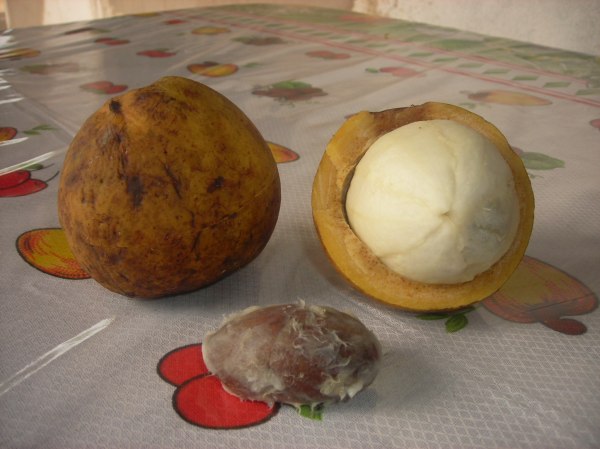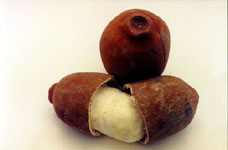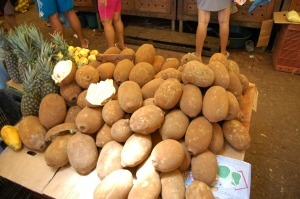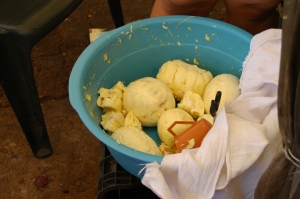Bacuri & Cupuaçu
“Time flies like an arrow; fruit flies like a banana”
-Groucho Marx (American Comedian, 1890-1977)
When we arrive in any new city, our first task is always to immediately hit the farmer’s market. In Belém, the mercado central is not like most markets – it’s the size of two city blocks that has an outdoor and an indoor section. The indoor section houses all of the fresh meat and Amazonian freshwater fish, while the outdoor section has a labyrinth of unique herbs, vegetables, medicinal remedies, food stands, juice shops, artisan craft vendors, and a fruit section unlike any other place in the world. The market, which sits on the very edge of the Amazon river basin at the bay of Guajará, is named ver-o-peso (“see-the-weight” in portuguese), following a colonial era tradition – the tax collector’s main post was located there (called “Casa do Haver-o-peso” or “measure the weight house”), and all goods brought from the Amazon forests, rivers and countryside were taxed by the Portuguese crown in the “Haver-o-peso house” , but only after their weight was measured – hence the name. Most of the products found in this market are completely exclusive to this area; you will not – and can not – find them anywhere else in the world.
Among the dozens of fruit displays, two of the most exclusively Amazonian fruits are Bacuri and Cupuaçu.
Bacuri
While walking through the market, a woman called our attention and offered us a slice of one of her products. It was orangeish-brown on the exterior and slightly oval shaped, about the size of a common orange. She sliced it around the center and removed the top half, revealing an opaque white oval surrounded by a yellowy bark. She then cut off a thin slice of the white pulp, which further revealed a large brown seed underneath. We were sold.
After the first bite, I thought I have never tasted anything like this before in my life. It’s a semi sticky pulp with a soft texture, and it’s incredibly fragrant. It’s very sweet but with a slight sour/acidic kick at the end – it’s absolutely delicious, and the rich flavor lingers in your mouth long after you swallow the pulp. After a few more bites, I had a vivid childhood flashback and immediately realized what flavor I was tasting – Fruit Loops! I could never figure out what fruit Fruit Loops actually tasted like until now. I know it’s a stretch (and I’m not sure that Alex totally agrees with me on this comparison) but I’m convinced that someone came to the Amazon, saw a colorful bird eating this fruit, tried it, had an epiphany, and sold the concept to Kellog’s. Coincidentally, the bacuri is actually pollinated by the white-bellied parrot. :p
It’s a little bizarre to eat – I’d guess that 80% of the fruit is inedible (the skin, bark, and seeds). A bacuri fruit usually contains two main seed compartments (filled with 1-5 seeds each), which most locals refer to as the “father”and the “son”. The “father” is the larger seed that has more pulp surrounding it, while the “son” is the smaller seed that is covered with only a very thin layer of pulp. The pulp of a bacuri doesn’t peel off – you either have to cut it with a very sharp knife, or you have to suck the seed and sort of extract the pulp with your saliva. Biting it really does nothing. The pulp is stringy, yet matted down against the seed; when you bite it, the pulp feathers out but doesn’t completely come loose.
Bacuri (pronounced BOK-ur-ri) contains notable amounts of phosphorus, iron, and vitamin C, and is mostly eaten raw or blended into juice. I’ve seen it used a lot in candies and confections (mainly in chocolate bon-bons) and as the base for artesinal ice creams here. Sometimes it’s sold preserved in sugar (“doce” in portuguese) – we acquired a kilo of “doce de bacuri” to take home 🙂
Bacuri is common (wild) in the Amazon region of northern Brazil from Maranhão to Goias. It’s abundant in the State of Pará, especially around Marajó and Salgado. Its native territory extends across the border into Colombia and northeast to the humid forests of Guyana. It’s seldom cultivated, but when the Indians clear the land for planting or pastures, they always leave this tree standing for the sake of its delicious fruits. The latex derived from the bark is also used in veterinary practice in Guyana, and the seeds contain an oil that is mixed with sweet almond oil to treat eczema and herpes.
You can’t really find bacuri anywhere outside of where it’s grown – I don’t remember ever seeing it in São Paulo or Sobral. Tasting fresh bacuri is definitely a good enough reason to come back to Belém!
Cupuaçu
One of the first juices I tried in São Paulo was cupuaçu (pronounced koo-poo-wah-SUE). Shortly before the new year, I got an email from a culinary newsletter touting cupuaçu as the “NEW superfood of 2010!” This made me slightly nauseated, because it’s almost certainly going to mean the exploitation of the native people in the regions where it’s grown so that American consumers can have watered-down juices and pills and powders and creams made from overpriced fruit overmarketed with superfluous claims of instant youth, beautiful skin, and an increase in sexual prowess (all sold by horribly written websites riddled with spelling and grammatical errors). Every time I google search in English, I run across the phrase “pharmacy in a bottle”… oh, please.
However, there’s a happy ending to my little tirade. A fellow cook from São Paulo told us that after speaking to a cupuaçu vendor in Belém, she learned that many of the vendors dilute the pulp they sell for exportation with cheaper fruits like banana and jaca – because people in other states and other countries will never know the difference unless they have actually traveled to Pará and tried the fruit fresh. Consumers, beware! 🙂
Anyway, Cupuaçu is a fruit native to the Amazon region that’s a cousin of the cacao (where chocolate comes from). The name comes from the Tupi words kupu (“that which looks like cacao”) + uasu (“large”). The fruits are oblong, brown, fuzzy, and hard like a coconut – they’re about 8-9″ long and fairly heavy (2-4lbs each). The inside contains a fragrant white pulp that surrounds 35ish seeds – it smells like a tart pineapple misted with chocolate and lime. It’s absolutely delicious, creamy, and unique – once it’s sweetened. By itself, cupuaçu is a little too sour and too acidic for my taste. Once again, you will almost never see cupuaçu fresh outside of this region – elsewhere in Brazil it’s sold almost exclusively in purees, juices, and “sweets” preserved in sugar syrup, which are used to make juices, cakes, ice creams, sorbets, candy fillings, jellies, liquor, cocktails, and the like. At ver-o-peso, we watched as a vendor separated the pulp from the bark – she took a large piece of wood and smacked the shell several times until it cracked. She then peeled the bark and separated the pulp into a bowl, weighed it, and bagged it for sale for the locals.
Health Benefits and uses
The fruit contains 11 known flavanoids, at least 9 antioxidants, and claims to lower blood pressure and improve circulation. It contains high levels of phytonutrients which add to its powerful antioxidant properties. The cupuaçu fruit is also rich in the types of fatty acids that support a healthy cholesterol level. The fiber content of the cupuaçu is high and it also contains the B vitamins as well as vitamins A and C.
Cupuaçu fruit has also been linked to providing a healthy immune system (vitamin C) and healthy-looking skin. Others claim it increases stamina and libido while naturally providing jitter-free energy since it contains theacrine instead of the xanthines (caffeine) found in cacao. The pulp, which hydrates similarly to cocoa butter, is also used in cosmetic products such as body lotions and facial creams. For centuries, cupuaçu seeds were traded along the Rio Negro and Upper Orinoco rivers – the indigenous people drank cupuaçu juice after it was blessed by a shaman to facilitate difficult births. The “beans” are utilized by the indigenous Tikuna people for abdominal pains.
Alternative uses
The bark of the cupuaçu, which is usually discarded or used as fertilizer, can actually be used in power generation. Projects using the shell as a source of biomass for energy production are currently being tested in a community in the state of Amazonas. By using a process called “incomplete combustion”, the shells can produce a gas instead of just smoke. When mixed with diesel-powered engines, this gas can reduce diesel consumption by up to 80%. The energy generated is used to fuel an agro-processing of the fruit which, before, was sold fresh. The costs are still higher than the generators that use diesel fuel only, but compensates by using abundant raw materials from the region, which generates many social and environmental benefits.
Controversy
There are initiatives throughout Brazil to develop Cupuaçu Chocolate, called “Cupulate”, which is already being produced and commercialized in Japan. There are a series of patents on the extraction of the fat from the cupuaçu seeds and the production of cupuaçu chocolate- almost all of which were registered by the company ASAHI Foods Co., Ltd. from Kyoto, Japan.
The “inventor”, Mr. Nagasawa Makoto, is both director of ASAHI Foods and owner of the US company “Cupuaçu International Inc” – which holds another world patent on the cupuaçu seed. Besides the patents, ASAHI Foods Co., Ltd. has registered the plant name “Cupuaçu” as a Trade mark for various product classes (including chocolate) in Japan, the European Union and in the US.
As a result, the cupuaçu was at the center of an international dispute for about six years. Brazilian organizations such as the GTA (Amazonian Working Group) and Amazonlink.org led a campaign which resulted in the cancellation of the trademark in Japan and in a law which confirmed cupuaçu as a Brazilian national fruit in May 2008. At the height of the conflict, the lawyers of ASAHI Foods threatened a company that sells cupuaçu jelly in Germany (another holder of the trademark “cupuaçu”) with fines exceeding $10,000 because of the use of the name “cupuaçu” on the label.
There is still a dispute going on in the EU over the rights of the use of the word “Cupuaçu” for certain products. When checking out export possibilities for sweets and other Cupuaçu products to Germany, Amazonlink.org was told to let the word “Cupuaçu” under no circumstances appear on the product.
I find this disturbing and ridiculous. Some things are just… not meant to be shared with the entire world. There’s a reason why everything doesn’t grow everywhere – it makes traveling exciting, and it gives communities and countries a distinct form of cultural identity. I’m sure I’ll crave many of the foods I tasted here when I return to the United States, but I won’t be buying them in any form – it won’t be the same, and frankly, I don’t want to drink all of the oil and fossil fuel that it would take to get it into a neatly packaged juice bottle in a commercial grocery store 4,000+ miles away from where it was grown. Without going off on too much of a tangent, I’d like to leave you with a quote from Michael Pollan (as I am rather fond of doing :p);
“The idea that any corporation could own a food crop, you know, is a very new idea. And it wasn’t until the 1980s that the Supreme Court said you could patent life. And that opened the flood gates. Efforts to patent the most valuable parts of life, which is to say, the crops on which we depend. […] When you genetically modify a crop, you own it. We’ve never had this in agriculture.”
-Michael Pollan, from an interview in the movie Food, Inc.






Just to play devil’s advocate here….. One can think about the exporting of various agricultural products outside of a region as a promotion of that region. People in other parts of the world will be able to try something they likely never even knew existed, and it may inspire them to travel to the place it came from to try it fresh. It’s also a way of allowing people who do not have the financial means or, perhaps, the opportunity to travel to actually experience and learn about other places and cultures. I’ve always wanted to travel, but have never had the opportunity to do so. That doesn’t stop me from learning things on my own though and the articles you and Alex have posted have been very informative!
great post. Love all the detail!
There are very few fruits on our supermarket shelves that haven’t travelled a very long way to get there. I lived in Brazil for a time, and I personally wish that cupuaçu was available here – it has a beautiful and unique flavour. However, of course I take on board your comments about the effect on the native population, but in a nation like Brazil which is expanding and advancing anyway I can’t see how stopping the export of cupuaçu will stop the changes that are happening there. This is a wonderful and interesting post – thank you for the info and perspective!
Hi Betty,
Just wanted to let you know, we recently found frozen cupuaçu in a store in Union Square, Boston. It’s the “icefruit” brand that you find all over Brazil – it’s so good in smoothies! =)